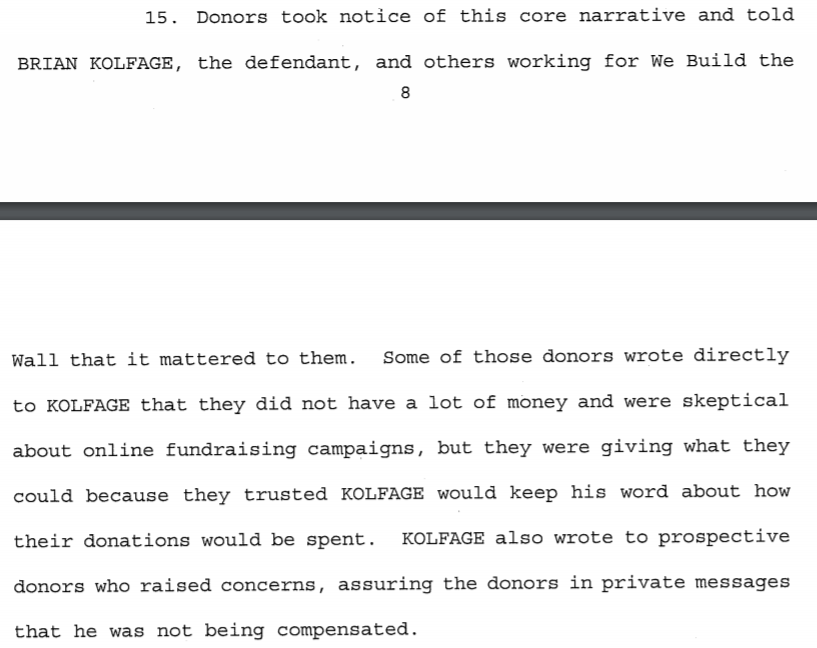Earlier today, federal postal inspectors arrested former Trump campaign chief executive (and Trump administration chief strategist) Steve Bannon. He’s charged with orchestrating “a scheme to defraud hundreds of thousands of donors” in connection with an online fundraising campaign called “We Build the Wall.”
The allegations are rather simple. Bannon and his indicted colleagues, Brian Kolfage and Andrew Badolato, pledged to “not take a penny in salary or compensation” as part of their efforts to build a border wall on America’s southern border. They said, “100% of the funds raised … will be used in the execution of our mission and purpose.” Prosecutors claim that “those representations were false.” Instead, Bannon and his colleagues diverted more than $1 million for their own personal use.
Sadly enough, the more I look at this case, the more it’s symbolic of the corruption that marks much of the populist right. It’s often difficult to discern where the political movement ends and the financial scam begins.
A brief history lesson is in order. The “We Build the Wall” campaign was launched on December 17, 2018. Why is that date significant? Because it came just after the GOP suffered devastating midterm election losses and were swept out of power in the House of Representatives. As a practical matter, it meant the likely death of Trump’s border wall dream.
The political loss created a sense of urgency on the right, but so did weeks of fearmongering about immigrant caravans. We may forget now, but day after day Fox News and other outlets relentlessly hyped the emerging “threat” of thousands of illegal immigrants swarming the southern border. Much of the rhetoric was hysterical. Trump called the caravan’s progress a “national emergency”:
He also called it an “invasion.”
He ordered thousands of troops to the border, a buildup so large that it came close to matching the size of American forces in Iraq. But Trump’s rhetoric was downright reasonable compared to some of the fearmongering on Fox News. One guest said that the migrants might bring “leprosy” to the United States:
Another Fox News guest said that immigrants were bringing a “polio-like paralysis of our children.” (Lou Dobbs, to his credit, pushed back on his guest’s worst claims):
Make no mistake, the message reached Trump’s base loudly and clearly, I had multiple conversations at church and elsewhere, mainly with older Republicans who expressed some of the same fears I just posted above. They said the word “invasion.” They worried about disease. And they believed that the border could be overrun with ease.
Is it any wonder that Bannon’s fundraising campaign was, in prosecutors’ words, “an immediate fundraising success”? It raised $17 million in its first week. Throughout the campaign, Bannon and his colleagues pledged repeatedly that they would take no money from the organization. They vowed that they were volunteers. And prosecutors provided evidence that donors believed them:

The Bannon indictment dropped days after the attorney general of New York filed suit seeking to dissolve the National Rifle Association. The case alleges decades of self-dealing and fraud on the part of NRA executives, including the diversion of more than $60 million in one three-year span.
While the attorney general is likely overreaching in her quest to dissolve the entire organization, the factual details in the complaint reflect extraordinarily lavish compensation, extraordinarily lavish travel arrangements, and massive levels of expense reimbursements.
Unsurprisingly, the mission suffered. The organization suffered. Writing in the Washington Post, Robert Spitzer detailed some rather ugly facts:
Since 2010, the NRA had drawn over $200 million in cash from its nonprofit NRA Foundation to keep its doors open. (The D.C. attorney general has also filed suit, charging the NRA with foundation funds misuse.) By the end of 2017, the NRA’s available assets were in the negative, to the tune of $31.8 million. Since 2009, its revenue grew only 0.7 percent per year, but expenses grew on average 6.4 percent annually. In 2018, the NRA raised $412 million but spent $423 million. Earlier this year, LaPierre reported to the NRA board that it had spent $100 million in the previous two years just on its legal problems.
The hits just keep on coming. Last summer my good friend, National Review’s Jim Geraghty, wrote an invaluable piece called, “The Right’s Grifter Problem.” He surveyed numerous reports and complaints about so-called “scam PACs”—political action committees that are fundamentally fraudulent—and some of the numbers he shared are simply eye-popping:
Back in 2014, Politico researched 33 political action committees that claimed to be affiliated with the Tea Party and courted small donors with email and direct-mail appeals and found that they “raised $43 million — 74 percent of which came from small donors. The PACs spent only $3 million on ads and contributions to boost the long-shot candidates often touted in the appeals, compared to $39.5 million on operating expenses, including $6 million to firms owned or managed by the operatives who run the PACs.”
And:
Back in 2015, RightWingNews reviewed the financial filings of 21 prominent conservative PACs and found the ten groups at the bottom of their list spent $54.3 million only paid out $3.6 million to help get Republicans elected.
This quote was particularly telling:
Back in 2016, campaign finance lawyer Paul H. Jossey detailed how some of the PACs operated and lamented, “the Tea Party movement is pretty much dead now, but it didn’t die a natural death. It was murdered — and it was an inside job. In a half decade, the spontaneous uprising that shook official Washington degenerated into a form of pyramid scheme that transferred tens of millions of dollars from rural, poorer Southerners and Midwesterners to bicoastal political operatives.”
It just keeps going and going and going:
In the 2018 cycle, Tea Party Majority Fund raised $1.67 million and donated $35,000 to federal candidates. That cycle, Conservative Majority Fund raised just over $1 million and donated $7,500 to federal candidates. Conservative Strikeforce raised $258,376 and donated nothing to federal candidates.
Put Vets First PAC raised $3.9 million in the 2018 cycle; they gave $9,000 to federal candidates.
Earlier this year, it was revealed that David Bossie’s group, Presidential Coalition, had raised $18.5 million in 2017 and 2018 to support state and local candidates in furtherance of the Trump agenda. Only $425,442, or 3 percent, went to direct political activity.
My friend Erick Erickson has also done yeoman’s work for years calling out these scams. And if there was a proper sense of justice and proportion in our never-ending right-wing civil wars, Jim’s National Review piece should have gone viral. It should have triggered a wave of soul-searching, house-cleaning, and accountability. But no. The grift continues.
To be clear, not every conservative group is a scam. Far from it. As a longtime employee of conservative nonprofits, I’m familiar with a very different lifestyle from Wayne LaPierre’s. I’ve stayed in more than my share of dingy hotels and pinched more than my share of pennies to try to sustain causes I believe in. Talk to my wife about the family financial sacrifice of leaving a law firm partnership to start defending religious freedom full-time.
When I worked at the Alliance Defending Freedom, for example, we were always keenly aware that not all our donors were wealthy. Some were older Americans who were digging deep to keep Bible studies in schools or pro-life activists out of jail. And so for me it is particularly infuriating to see widespread financial abuse and exploitation in important institutions and significant segments of the American right. They are victimizing financially-vulnerable Americans, and they know it.
It is even more infuriating when we know that much of that money is raised not just through pure fearmongering, but also through abject fakery. Casting themselves as men (and women) of the people—avatars of the working class—this allegedly populist fundraising class intentionally and cynically lines their pockets with the hard-earned dollars of the very people they purport to represent. It’s the corrupt televangelist’s playbook, applied to politics.
These fundraising scams fit seamlessly within a larger conservative media ecosystem that thrives on abject alarmism. Much of prime-time Fox is built around the idea that “they” are “coming for you.” Oh, and buy gold to weather the coming storm. Or, maybe, buy silver.
Yes, I know there is fraud and outrage-bait on the left. The Southern Poverty Law Center, for example, has built up an immense war chest hyping the threat of violent right-wing extremism. But I didn’t grow up in the progressive movement. I don’t live in progressive America. I’m less familiar with that world.
The older Americans I know are mainly conservative, and the fears they express are being sold to them by celebrities on the right. It’s a crying shame that so many of our seniors are spending their golden years literally frantic with worry about the country they love, writing checks to con men who care only for cash.
One last thing…
As the NBA bubble demonstrates (at least so far), it seems like with sufficient resources and sufficient care, it is possible to safely play contact sports. So I’m rooting for college football to get it right. I’m rooting for the SEC to take the field. Take care of the players, and play the game. If you can’t take care of the players, don’t play the game. But if anyone in college sports has the resources to make it happen, it’s the SEC.
Okay, with all those cautionary notes out of the way, I must confess that I got a chuckle out of the video below. Southern readers especially, enjoy:
Photograph by Joel Saget/AFP/Getty Images.







Please note that we at The Dispatch hold ourselves, our work, and our commenters to a higher standard than other places on the internet. We welcome comments that foster genuine debate or discussion—including comments critical of us or our work—but responses that include ad hominem attacks on fellow Dispatch members or are intended to stoke fear and anger may be moderated.
With your membership, you only have the ability to comment on The Morning Dispatch articles. Consider upgrading to join the conversation everywhere.